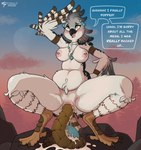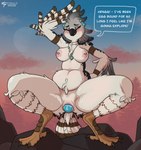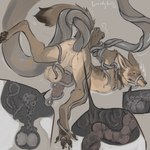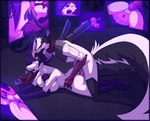
oviposition
Oviposition is the process of laying eggs, which is a natural reproductive step for most fishes, amphibians, reptiles, birds, and monotremes. Evolutionary science suggests that all animals once laid eggs, but many animals evolved into live birth for improved survival of offspring.
As a tag, oviposition describes eggs exiting a body into an external environment, usually from an orifice like a pussy or ovipositor but also from more fetishized regions like an anus, urethra, or even a tentacle. An oviposition post may suggest that a body will lay one or a few eggs, or perhaps that a single body will lay a clutch of tens or even hundreds of eggs.
Orifices
- egg_from_ass
- egg_from_cloaca
- egg_from_mouth
- egg_from_nipples
- egg_from_ovipositor
- egg_from_penis
- egg_from_pussy
- egg_from_urethra
Timeline
The oviposition tag requires current egg-laying.
imminent oviposition
Eggs are not visible from the exterior of a body, but we know that a character is in labor with egg(s) or that egg(s) are now being conveyed from within a body to an orifice. Do not tag this with oviposition.
during oviposition
1. An egg is exiting an orifice, often stuck and requires straining from the egg-layer to push it out. This may resemble crowning, the stage of birth where only the top of the child's head is visible, but that tag should remain separate from oviposition.
2. An egg has completely exited the body just moments ago. There may be:
- motion_lines indicating the egg's travel or shaking from the egg-layer's body
- bodily_fluids still connecting the egg to the egg-layer (i.e., [fluid_type]_string tag) or such a trail between the egg and its exited orifice
- gaping_[orifice] that the egg exited
3. (Optional) The egg-layer appears to have more eggs to lay and the cycle repeats. Signs for this may include:
- continued straining, pain, shaking, or muscle tension
- be aware that a body exiting labor should still exhibit similar aftershocks as it returns to a neutral state
- internal view showing more eggs
- translucent_body revealing egg shapes
- various round [body_part]_bulges where the egg was stored within the body (e.g., abdominal_bulge) or along the path it exited (e.g., urethral_bulge)
- big_belly should be regarded with plenty of skepticism for this because bellies shouldn't magically deflate to pre-pregnancy proportions moments after oviposition
- at best, a judgment call can be made between current belly size, expected non-pregnant belly size, and the volume of eggs already laid (e.g., very large belly + low relative volume of eggs laid = very likely more eggs will be laid)
after oviposition
Oviposition of all eggs is complete. Some amount of freshly laid eggs are present, perhaps still wet with bodily_fluids. The egg-laying character may appear exhausted, relieved, relaxed, or happy but not tense or pained. In many cases with art, the once-pregnant character recovers impossibly fast, where their body proportions immediately return to normal sizes and they may even appear ready for physical activity.
Tagging Issues
birth - eggs are not born. Never tag oviposition with birth. Moreover, newborn babies are countable characters but eggs are not.
- birth subtags - never tag oviposition with any birth subtags. Ever. Use an equivalent oviposition tag instead or create one if needed.
abdominal_bulge / other bulges - only tag egg-bearing body parts with [body_part]_bulge tags when those body parts have egg bulges. A perfectly round belly known to contain eggs should not be tagged abdominal_bulge.
egg_insertion - this is not oviposition unless the egg has first exited one body, such as via ovipositor or egg laying tentacle, before being inserted into a body.
- egg_play - using an egg as an improvised_sex_toy, where the egg may be inserted into and removed from an orifice multiple times, falls outside the intent of the oviposition tag. If the egg originated from the orifice, then oviposition still applies.
hatching - the organism within an egg has finished its egg-bound development, cracks its shell, and emerges. This is neither oviposition nor birth.
- internal_hatching - in very rare cases eggs hatch within a character and then the offspring exits the character. Tag this birth and not oviposition. Some real egg-laying animals can switch to live births as they adapt to their environment.
larva - these develop from eggs and are not eggs themselves.
parasite / infestation - a harmful foreign creature that has somehow entered or attached to a host body and consumes its nutrients. By definition, a host infested with parasites should never count toward pregnancy and therefore oviposition; however, parasitism in art has unusual variations and must be judged on a case-by-case basis.
For instance, parasitism involving corruption and/or assimilation could feature oviposition. For the sake of simplicity, a parasite's eggs exiting a host body is still oviposition.
penetration - eggs exiting a body never count as penetration. Tag with the correct [orifice]_oviposition tag instead of any penetration tags.
pregnancy - this is the development of offspring within a character, including eggs. Thus, offspring currently exiting a character's body are no longer considered developing within that body and do not count toward pregnancy. Regardless, furry pregnancy art often features multiple offspring and determining if an ovipositing character has more eggs within them often isn't possible.
See also
- egg_insertion - Eggs being put into an orifice by any means.
- oviposition - The process of laying eggs.
- ovipositor - An organic structure used to deposit or lay eggs.
The following tags are aliased to this tag: egg_laying, egglaying, laying_egg, laying_eggs, ovi, ovipositioning (learn more).
This tag implicates egg (learn more).
The following tags implicate this tag: egg_from_ass, egg_from_cloaca, egg_from_mouth, egg_from_nipples, egg_from_ovipositor, egg_from_pussy, egg_from_urethra, forced_oviposition (learn more).


